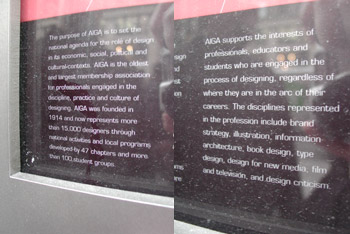It’s 3pm in Seattle and I’m listening to 950AM Sports Radio, following all the basketball scores. At the break, I hear a string of advertisements from the likes of Verizon, Ford, Kia, and Mr. Goodwrench. But then, I hear a public service announcement by the A.I.A. (American Institute of Architects). The takeaway is that buildings are better when designed by an AIA certified architect. A school becomes something more, something greater. AIA architects give back to the community.
Minutes after hearing this public service announcement, I discovered an envelope from the AIGA in my mailbox. It included three orange booklets entitled What every business needs. The pamphlets are intended to help designers communicate with clients.
AIA’s psa and AIGA’s pamplet share a similar tone of voice: we’re here to help and improve things. However, the methods of delivery and target audiences differ. A sports radio listener (general public) learns something new about architecture while a designer (insider) gets a pamphlet telling them to do what they’re probably already doing. I don’t know a designer who doesn’t promote design.
Why didn’t the AIGA target the intended audience—executives—instead of having designers play messenger? And how long will it take before the AIGA promotes design through public service announcements on the radio, interrupting your news, music, or sports? Or are there other media channels they should consider, like direct mail, pamphlets, or billboards?







public service announcements are quite expensive. plus it reaches probably wider of an audience than aiga intends to reach. so this might be a cost/payoff issue.
i don't think the pamphlets are meant for us designers, but for us to use them as support materials. however, while i think they are "cute" and the content might be good, i think they will not get much of an executives interest. i think the format fails miserably.
does AIGA send them to executives as well?
ps
On Mar.18.2004 at 05:58 PM